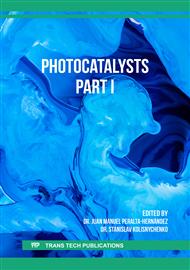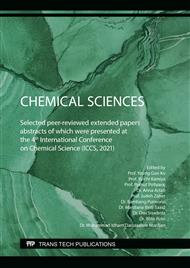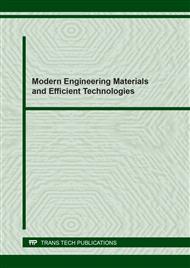[1]
A. Amobonye, P. Bhagwat, S. Singh, S. Pillai, Plastic biodegradation: Frontline microbes and their enzymes, Sci. Total Environ. 759 (2021) 143536.
DOI: 10.1016/j.scitotenv.2020.143536
Google Scholar
[2]
S. Sharma, A. Umar, S. Sood, S.K. Mehta, S.K. Kansal, Photoluminescent C-dots: An overview on the recent development in the synthesis, physiochemical properties and potential applications, J. Alloys Compd. 748 (2018) 818–853.
DOI: 10.1016/j.jallcom.2018.03.001
Google Scholar
[3]
M.C. Krueger, H. Harms, D. Schlosser, Prospects for microbiological solutions to environmental pollution with plastics, Appl. Microbiol. Biotechnol. 99 (2015) 8857–8874.
DOI: 10.1007/s00253-015-6879-4
Google Scholar
[4]
B. Gewert, M.M. Plassmann, M. Macleod, Pathways for degradation of plastic polymers floating in the marine environment, Environ. Sci.: Processes Impacts 17 (2015) 1513–1521.
DOI: 10.1039/c5em00207a
Google Scholar
[5]
D. Danso, J. Chow, W.R. Streit, Plastics: Environmental and biotechnological perspectives on microbial degradation, Appl. Environ. Microbiol. 85 (2019) e01095-19.
DOI: 10.1128/aem.01095-19
Google Scholar
[6]
I. Ahmad, M.I. Khan, M. Ishaq, H. Khan, K. Gul, W. Ahmad, Catalytic efficiency of some novel nanostructured heterogeneous solid catalysts in pyrolysis of HDPE, Polym. Degrad. Stab. 98 (2013) 2512–2519.
DOI: 10.1016/j.polymdegradstab.2013.09.009
Google Scholar
[7]
Y. Hu, J. Yang, J. Tian, L. Jia, J.S. Yu, Green and size-controllable synthesis of photoluminescent carbon nanoparticles from waste plastic bags, RSC Adv. 4 (2014) 47169–47176.
DOI: 10.1039/c4ra08306g
Google Scholar
[8]
H. Wang, Z. Wei, H. Matsui, S. Zhou, Fe3O4/carbon quantum dots hybrid nanoflowers for highly active and recyclable visible-light driven photocatalyst, J. Mater. Chem. A 2 (2014) 15740–15745.
DOI: 10.1039/c4ta03130j
Google Scholar
[9]
Y. Han, H. Huang, H. Zhang, Y. Liu, X. Han, R. Liu, H. Li, Z. Kang, Carbon quantum dots with photoenhanced hydrogen-bond catalytic activity in aldol condensations, ACS Catal. 4 (2014) 781−787.
DOI: 10.1021/cs401118x
Google Scholar
[10]
X. Guo, H. Zhang, H. Sun, M.O. Tade, S. Wang, green synthesis of carbon quantum dots for sensitized solar cells, ChemPhotoChem 1 (2017) 116–119.
DOI: 10.1002/cptc.201600038
Google Scholar
[11]
Y. Hu, Z. Gao, J. Yang, H. Chen, L. Han, Environmentally benign conversion of waste polyethylene terephthalate to fluorescent carbon dots for 'on-off-on, sensing of ferric and pyrophosphate ions, J. Colloid Interface Sci. 538 (2019) 481–488.
DOI: 10.1016/j.jcis.2018.12.016
Google Scholar
[12]
R. Malik, S. Lata, U. Soni, P. Rani, R.S. Malik, Carbon quantum dots intercalated in polypyrrole (PPy) thin electrodes for accelerated energy storage, Electrochim. Acta 364 (2020) 137281.
DOI: 10.1016/j.electacta.2020.137281
Google Scholar
[13]
A. Kumari, A. Kumar, S.K. Sahu, S. Kumar, Synthesis of green fluorescent carbon quantum dots using waste polyolefins residue for Cu2+ ion sensing and live cell imaging, Sens. Actuators, B 254 (2018) 197–205.
DOI: 10.1016/j.snb.2017.07.075
Google Scholar
[14]
S. Mondal, E.K. Karthik, L. Sahoo, K. Chatterjee, M. Sathish, U.K. Gautam, High and reversible oxygen uptake in carbon dot solutions generated from polyethylene facilitating reactant-enhanced solar light harvesting, Nanoscale 12 (2020) 10480–10490.
DOI: 10.1039/d0nr00266f
Google Scholar
[15]
M.I.S.D. Cruz, N. Thongsai, M.D.G. de Luna, I. In, P. Paoprasert, Preparation of highly photoluminescent carbon dots from polyurethane: Optimization using response surface methodology and selective detection of silver (I) ion, Colloids Surf., A 568 (2019) 184–194.
DOI: 10.1016/j.colsurfa.2019.02.022
Google Scholar
[16]
J. Chattopadhyay, C. Kim, R. Kim, D. Pak, Thermogravimetric characteristics and kinetic study of biomass co-pyrolysis with plastics, Korean J. Chem. Eng. 25 (2008) 1047–1053.
DOI: 10.1007/s11814-008-0171-6
Google Scholar
[17]
J.H. Lin, Y.J. Pan, C.F. Liu, C.L. Huang, C.T. Hsieh, C.K. Chen, Z.I. Lin, C.W. Lou, Preparation and compatibility evaluation of polypropylene/high-density polyethylene polyblends, Materials 8 (2015) 8850–8859.
DOI: 10.3390/ma8125496
Google Scholar
[18]
S.H. Song, M. Jang, H. Yoon, Y.H. Cho, S. Jeon, B.H. Kim, Size and pH-dependent photoluminescence of graphene quantum dots with low oxygen content, RSC Adv. 6 (2016) 97990–97994.
DOI: 10.1039/c6ra21651j
Google Scholar
[19]
H. Ding, S.B. Yu, J.S. Wei, H.M. Xiong, Full-color light-emitting carbon dots with a surface-state-controlled luminescence mechanism, ACS Nano, 10 (2016) 484–491.
DOI: 10.1021/acsnano.5b05406
Google Scholar
[20]
E.A. Stepanidenko, I.A. Arefina, P.D. Khavlyuk, A. Dubavik, K.V. Bogdanov, D.P. Bondarenko, S.A. Cherevkov, E.V. Kundelev, A.V. Fedorov, A.V. Baranov, V.G. Maslov, E.V. Ushakova, A.L. Rogach, Influence of the solvent environment on luminescent centers within carbon dots, Nanoscale 12 (2020) 602–609.
DOI: 10.1039/c9nr08663c
Google Scholar
[21]
A. Mewada, S. Pandey, S. Shinde, N. Mishra, G. Oza, M. Thakur, M. Sharon, M. Sharon, Green synthesis of biocompatible carbon dots using aqueous extract of Trapa bispinosa peel, Mater. Sci. Eng., C 33 (2013) 2914–2917.
DOI: 10.1016/j.msec.2013.03.018
Google Scholar




